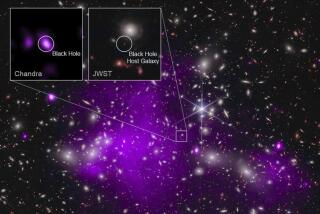Physicists find ‘tantalizing hints’ of Higgs boson ‘God particle’
Physicists announced Tuesday that they had detected “tantalizing hints,” but not definitive proof, of the long-sought Higgs boson, the so-called God particle that is crucial to physicists’ understanding of why mass exists in the universe.
Two large teams of scientists based at the Large Hadron Collider near Geneva separately saw what they believe are telltale tracks of the maddeningly elusive particle in the aftermath of about 400 trillion proton collisions carried out since January.
Neither group had solid enough evidence to announce an official discovery, they reported. But the fact that both teams generated similar results — and that those results were in good alignment with the predictions of theoretical physicists — indicated that scientists may be closing in on the Higgs at last.
GRAPHIC: How the collider works
“It’s looking very good,” said UC Davis theoretical physicist John Gunion, who was not involved in the experiments but has been following them closely. “What’s really important is that both teams see the same thing.”
The results were presented Tuesday afternoon in a packed auditorium at the Large Hadron Collider, which is operated by CERN, the European Organization for Nuclear Research.
The collider sends beams of protons hurtling toward each other at nearly the speed of light. Two massive detectors, known as ATLAS and CMS, analyze the subatomic particles released by the collisions. Certain patterns are thought to indicate that a collision has produced a Higgs boson.
Both teams reported possible Higgs sightings that suggested the particle has a relatively light mass, somewhere around 125 billion electron volts.
But the margins of error for those sightings were still considerable: The ATLAS team said its calculations came with a statistical significance of about 2.3 sigma and the CMS team said its was about 1.9 sigma.
Once the teams’ results are carefully combined, the significance could rise above 3 sigma, Caltech physicist Sean Carroll said. Physicists require a significance of at least 3 sigma before considering a finding “evidence,” and they need to reach the 5-sigma threshold to declare they’ve made a “discovery.”
Data from additional experiments will allow both teams to narrow their margins of error and determine whether the Higgs signal is real, said Fabiola Gianotti, a physicist on the ATLAS team.
“By the end of 2012 — sooner, if we are lucky — we should be able to have the final word,” Gianotti told those gathered at CERN.
In a post on the Cosmic Variance blog, Carroll compared the news to “rushing to the tree on Christmas morning, ripping open a giant box, and finding a small note that says ‘Santa is on his way! Hang in there!’”
The CERN results have been eagerly anticipated by physicists hoping to find experimental support for the Standard Model of particle physics, the theory that explains how subatomic particles interact to make up the building blocks of the universe.
But an important piece of evidence supporting the Standard Model never materialized: the Higgs boson. It is the particle associated with the so-called Higgs field, an energy field that gives mass to particles through a process known as the Higgs mechanism. (All are named for University of Edinburgh physicist Peter Higgs, one of several scientists who proposed the idea during the 1960s.)
If the theory is correct, scientists should be able to detect the Higgs boson, or multiple Higgs bosons, by smashing subatomic particles together at high energies, simulating conditions in the early universe.
Older particle accelerators, including the Tevatron at Fermilab in Batavia, Ill., were able to narrow the range of possible masses for the Higgs, but they weren’t powerful enough to find the particle. The search was one of the primary reasons for building the $5-billion Large Hadron Collider.
Whether additional data prove or rule out the existence of the Higgs boson next year, scientists said, there are many years of physics research left to conduct at the collider.
If the particle is there, researchers will investigate its properties. If the particle isn’t there, “then something else has to show up in our experiments,” said Markus Klute, an MIT physicist who works with the CMS team.
Either way, he said, “we start a new chapter in Higgs physics.”
GRAPHIC: How the collider works
More to Read
Start your day right
Sign up for Essential California for news, features and recommendations from the L.A. Times and beyond in your inbox six days a week.
You may occasionally receive promotional content from the Los Angeles Times.







